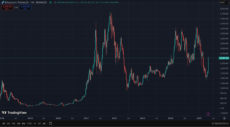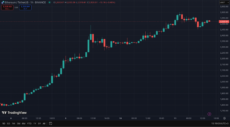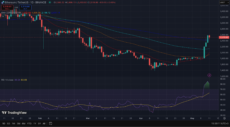This guide explains how to buy TOKEN6900, a new meme coin project with an attractive market capitalization. Learn how to join the ...
Comprehensive Ethereum Price Prediction: Analyzing Future Trends and Market Dynamics
Last Updatedby Tony Frank · 23 mins read

Ethereum is more than a cryptocurrency — it’s the backbone of DeFi, NFTs, and Web3 innovation. This in-depth guide analyzes ETH’s historical performance, market dynamics, and price forecasts, helping investors navigate risks, opportunities, and the evolving blockchain landscape.
Key Notes:
- Ethereum’s price is driven by network activity, supply-reducing upgrades like EIP-1559, and its foundational role in powering DeFi, NFTs, and smart contracts.
- Institutional adoption, Ethereum ETFs, and technical advancements such as sharding and Layer 2 solutions are key catalysts for medium- to long-term growth.
- Despite rising competition from alternative blockchains, Ethereum’s developer dominance and ecosystem depth support a strong long-term outlook through 2030.
Ethereum has become more than just a cryptocurrency — the infrastructure layer powering thousands of decentralized applications, financial protocols, and tokenized ecosystems. As adoption accelerates and the technology evolves, interest in Ethereum’s long-term value proposition grows accordingly.
This article comprehensively examines the factors that shape Ethereum’s price, including short-term and long-term forecasts and the broader market forces influencing its trajectory. From technical indicators and macroeconomic trends to regulatory dynamics and the rise of Ethereum ETF, we explore what’s next for ETH in an increasingly complex and competitive digital asset landscape.

Photo: Ethereum Official Website.
Historical Performance of Ethereum (ETH) Price
Since its inception in 2015, Ethereum has evolved from its early stages as a novel cryptocurrency project to a foundational pillar of the blockchain economy. Initially priced under $1, each Ethereum block has since become part of a narrative of exponential growth.
The 2017 bull run saw ETH surge past $1,400, only to retrace sharply during the subsequent correction. In 2020–2021, a significant increase in decentralized finance activity, widespread adoption of NFTs, and the Ethereum shift toward Proof-of-Stake (culminating in the Merge) reignited upward momentum.
Current price of ETH is ETH $2 514 24h volatility: 1.5% Market cap: $303.49 B Vol. 24h: $12.83 B .

ETH Price Historical Data. Photo: TradingView.
These developments — coupled with innovations from the Ethereum Foundation, rising interest in staked ETH, and a growing number of users treating ETH as a digital alternative to a traditional bank account — have kept Ethereum resilient despite volatility.
Each milestone has influenced price dynamics, from technical upgrades to tokenomics changes like EIP-1559 in the London Hard Fork. Looking back at Ethereum’s historical performance offers perspective and context for future expectations, reinforcing the challenges and possibilities that lie ahead.
Factors Influencing Ethereum’s Price
A complex interplay of internal mechanics and external pressures shapes Ethereum’s market valuation. Multiple forces continuously affect ETH’s price, from its evolving protocol design to global regulatory shifts and rising competition in the Layer 1 space. Understanding these factors is essential for anyone looking to assess Ethereum’s long-term potential or make informed investment decisions in an increasingly fragmented blockchain landscape.

ETH Today’s Price. Photo: TradingView.
Supply and Demand Dynamics
At its core, Ethereum’s price is governed by the fundamental economic principle of supply and demand. The introduction of Ethereum’s EIP-1559 upgrade, which implemented a base fee burn mechanism, has had a deflationary effect on the supply of ETH. As more ETH is burned with each transaction, the circulating supply decreases, especially during periods of high network activity.

Photo: Ethereum Official Website.
Simultaneously, demand is shaped by the network’s utility across various sectors, including DeFi, NFTs, and enterprise applications. The interaction between limited supply and increasing use cases creates natural upward pressure on Ethereum’s valuation.
Technological Advancements in the Ethereum Network
Ethereum’s ongoing technical evolution significantly impacts its market value. The transition from Proof-of-Work to Proof-of-Stake via the Merge in 2022 marked a pivotal moment, drastically reducing energy consumption and laying the groundwork for future scalability upgrades.
Innovations like sharding and Layer 2 solutions (e.g., Optimism, Arbitrum) aim to enhance transaction throughput and reduce gas fees, improving user experience and encouraging broader adoption. Each successful upgrade reinforces Ethereum’s position as a leading smart contract platform and contributes to long-term investor confidence.
In May 2025, Ethereum developers successfully activated the Pectra upgrade on the mainnet — the most significant update since the Merge in 2022. Pectra combines two major hard forks: Prague (execution layer) and Electra (consensus layer), introducing 11 Ethereum Improvement Proposals (EIPs), including EIP-7702 and EIP-7251. These enhancements aim to boost scalability, improve user experience, and optimize staking operations across the network.
EIP-7702 enables “smart accounts,” temporarily allowing standard wallets to act like smart contracts. This feature supports multi-action transactions, sponsored gas fees, and payment in tokens other than ETH. Meanwhile, EIP-7251 raises the staking limit per validator from 32 ETH to 2048 ETH, streamlining node operations for institutional participants and reducing overall network load.
Additional upgrades, such as increased data throughput for Layer 2 solutions, further lower transaction costs, and enhance efficiency. While the immediate price impact of Pectra has been modest, the upgrade strengthens Ethereum’s technical foundation and positions it for continued leadership in the Web3 ecosystem.
Read more about the Pectra upgrade in our in-depth guide: Understanding Ethereum’s Pectra Upgrade: Key Features and Implications.
Growth of Decentralized Finance (DeFi) and Smart Contracts
Ethereum’s role as the backbone of the DeFi movement has been instrumental in driving demand for ETH. Platforms such as Uniswap, Aave, and MakerDAO rely on Ethereum’s infrastructure, using ETH as collateral and a transactional medium.
The proliferation of smart contracts has unlocked countless financial primitives — from lending and trading to derivatives and insurance — creating sustained on-chain activity and liquidity. As DeFi matures and attracts institutional interest, Ethereum benefits from network effects that directly influence its market capitalization.
Competition from ‘Ethereum Killers’
While Ethereum remains the dominant Layer 1 platform, its lead is constantly challenged by a growing list of so-called “Ethereum killers” — including Solana, Avalanche, Cardano, and more recently, Sui and Aptos. These alternative chains often promise faster throughput, lower fees, or enhanced scalability.
| Feature | Ethereum | Solana | Avalanche | Cardano | Sui | Aptos |
| Consensus Mechanism | Proof of Stake (Ethereum 2.0) | Proof of History + PoS | Avalanche Consensus + PoS | Ouroboros PoS | Delegated PoS | Delegated PoS |
| TPS (Transactions/sec) | ~30–60 (base layer) | ~65,000+ (theoretical max) | ~4,500+ (on C-Chain) | ~250 | ~120,000+ (theoretical) | ~160,000+ (theoretical) |
| Finality | ~15 seconds | ~1–2 seconds | ~1–2 seconds | ~5–20 seconds | Sub-second | <1 second |
| Smart Contract Language | Solidity | Rust | Solidity (on C-Chain via EVM) | Plutus (Haskell-based) | Move (customized) | Move (customized) |
| Developer Ecosystem | Largest, most mature | Active, high-speed growth | EVM-compatible, growing fast | Academically driven, slower rollout | Early stage, growing rapidly | Developer-friendly, Meta-origin |
| Decentralization | High—global node distribution, public governance | Moderate — lower node count, high throughput focus | Moderate — multiple chains, but the number of validators is fewer | High — academic and governance-led | Low to moderate — early phase | Low to moderate — backed by large investors |
| Security | Proven, robust, and supported by a large community | Mixed — past outages | Good, but still maturing | High—formal verification | Experimental, still under scrutiny | Experimental, focused on scalability |
| Sustainability | Carbon neutral after PoS transition | Energy-efficient PoS | Energy-efficient PoS | Energy-efficient PoS | Energy-efficient | Energy-efficient |
| Governance | Open-source, community, and Ethereum Foundation driven | Foundation-led | Foundation + community | Governance by design (slow-moving) | In development | In development |
| Unique Differentiator | Ethical focus, decentralization, regulatory alignment (the “good guys”) | Ultra-high speed and cheap fees | Subnet architecture | Formal methods, peer-reviewed updates | Object-based model, Move language | Parallel execution with Move |
| Notable Criticisms | High gas fees, relatively slow scaling | Centralization risks, network outages | Complex architecture, fragmented tooling | The development pace is too slow | Unproven at scale | Heavy VC backing, unclear decentralization |
While newer chains like Solana, Sui, and Aptos prioritize performance and scalability, often at the cost of decentralization, Ethereum positions itself as the ethical, open, and regulatory-aligned foundation of Web3. Its focus on decentralization, security, and long-term vision has earned it the trust of developers, institutions, and policymakers alike, even as it trades off speed and scalability in the short term.
Expert Predictions
Who |
Year |
Price |
Investor, analyst Ted Pillows |
June 2025 |
$3450 |
CryptoQuant |
2025 |
$5000 |
Standard Chartered |
2025 |
$4000 |
Standard Chartered |
2026 |
$6000 |
Standard Chartered |
2027 |
$7500 |
Cardano Founder Charles Hoskinson |
2035-2040 |
$0 |
Investor and analyst Ted Pillows has forecast that Ethereum (ETH) could reach $3,450 by June 2025, citing technical analysis. He highlights that ETH is currently retesting a long-term support zone — a level that has historically triggered major rallies, including gains of over 2,000% and 360% in past market cycles. A rebound from this zone could drive a 65% increase from the $2,000 range, potentially aligning with the lower boundary of Ethereum’s current descending channel resistance.
$ETH has retested its multi-year trendline support level.
Since 2021, Ethereum has retested this level only thrice.
June 2022, November 2022 and March 2025.
The last 2 times, the market the cycle bottom, and I'm hoping this time won't be different. pic.twitter.com/Q94DFOBUeC
— Ted (@TedPillows) March 23, 2025
Meanwhile, institutional perspectives on Ethereum’s future vary. Standard Chartered recently revised its year-end 2025 price target for ETH from $10,000 to $4,000. The bank attributes this downgrade to structural issues within Ethereum’s ecosystem, particularly the growing dominance of Layer 2 solutions like Coinbase’s Base. While these solutions enhance scalability, they also siphon off value from the Ethereum main net. In fact, Base alone is estimated to have reduced Ethereum’s market capitalization by $50 billion.
Geoff Kendrick, Standard Chartered’s head of digital assets research, warned that Ethereum’s transition to proof-of-stake and the expansion of Layer 2 platforms have commoditized the protocol, eroding its ability to capture value.
Ethereum’s economic model may continue to weaken without proactive measures, such as introducing fees for Layer 2 networks. Nevertheless, the bank maintains a cautiously optimistic outlook, projecting a potential rebound to $6,000 in 2026 and $7,500 by 2027 if key structural challenges are addressed.
Contrasting this, blockchain analytics firm CryptoQuant offers a more bullish near-term view. It projects that Ethereum could exceed $5,000 in 2025, supported by growing institutional demand and rising network activity.
According to the firm, daily transactions have climbed to between 6.5 and 7.5 million — up from around 5 million a year earlier. Additionally, Ethereum-based ETFs have seen record-breaking inflows, with $1.2 billion in new capital invested over a week. These trends suggest strong demand fundamentals that could drive ETH to new highs.
However, skepticism remains in parts of the crypto community. Cardano founder Charles Hoskinson has predicted Ethereum’s eventual demise within the next 10 to 15 years. In an April 23 AMA session, he argued that Ethereum suffers from fundamental architectural weaknesses — including its accounting model, virtual machine, and consensus design — that could undermine its long-term viability.
He also criticized the ecosystem’s increasing dependence on Layer-2 networks, warning that they fragment the ecosystem and siphon value from the main chain. According to Hoskinson, Ethereum may struggle to maintain user cohesion unless these issues are resolved, and face a long-term decline in favor of more efficient alternatives.
Short-Term Ethereum Price Forecast
In the short term, Ethereum’s price is susceptible to market sentiment, technical patterns, and fast-moving developments across the crypto space. Traders and analysts closely monitor momentum indicators, funding rates, and macro signals to gauge potential price action. While long-term fundamentals remain strong, Ethereum’s short-term movements often reflect shifts in investor psychology, liquidity flows, and sudden news events.
Current Market Sentiment and Technical Indicators
Currently, Ethereum is trading in a zone of heightened volatility, with price action closely correlated to broader movements in Bitcoin and traditional risk assets. Technical indicators, such as the Relative Strength Index (RSI) and 50-day and 200-day Moving Averages, suggest that ETH is in a consolidation phase, with neither bulls nor bears firmly in control.
As reflected in the Crypto Fear and Greed Index and social media activity, market sentiment remains cautious following recent liquidity and regulatory news fluctuations. Traders are eyeing key resistance and support levels around psychologically significant price points, which could define the next directional move.
Potential Immediate Challenges and Opportunities
In the immediate term, Ethereum faces several challenges that could pressure its price. Uncertainty around regulatory enforcement in major jurisdictions, particularly the U.S., continues to weigh on market confidence. Additionally, any technical hiccups in upcoming network upgrades or congestion issues could affect the user experience and reduce transaction volume.
On the other hand, renewed interest in DeFi protocols, Ethereum staking, or positive developments in Layer 2 adoption could trigger bullish momentum. A surprise upside in macroeconomic indicators, such as inflation data or interest rate decisions, could also be a short-term catalyst for ETH.
| Month | Minimum Price | Average Price | Maximum Price | Potential ROI |
| May 2025 | $ 1,377.91 | $ 1,855.33 | $ 2,645.80 | 4.92% |
| Jun 2025 | $ 1,190.42 | $ 1,430.65 | $ 1,662.88 | 34.06% |
| Jul 2025 | $ 1,182.63 | $ 1,510.26 | $ 2,003.06 | 20.57% |
| Aug 2025 | $ 1,948.31 | $ 2,138.89 | $ 2,469.94 | 2.05% |
| Sep 2025 | $ 1,851.82 | $ 2,080.19 | $ 2,281.08 | 9.54% |
| Oct 2025 | $ 2,213.02 | $ 2,616.68 | $ 2,989.41 | 18.55% |
| Nov 2025 | $ 2,542.49 | $ 2,723.45 | $ 2,937.26 | 16.48% |
| Dec 2025 | $ 2,348.90 | $ 2,488.35 | $ 2,571.74 | 1.99% |
Medium-Term Ethereum Price Forecast
Looking beyond immediate market fluctuations, Ethereum’s medium-term outlook — spanning the next two to three years — hinges on the network’s ability to scale, sustain user growth, and maintain developer momentum.
While short-term price action is often reactive, medium-term forecasts consider structural trends, adoption curves, and macro-level capital flows. This period will also likely reveal the impact of Ethereum’s transition to a more energy-efficient and economically sustainable model after the Merge.
Predictions for the Next 2–3 Years
Analysts project a cautiously optimistic trajectory for Ethereum from 2025 to 2027. Assuming continued progress on scalability through rollups and sharding, Ethereum could solidify its role as the dominant smart contract platform.
Price forecasts vary depending on market conditions, but many expect ETH to challenge previous all-time highs, provided that overall crypto market sentiment remains constructive. Broader adoption of Web3 technologies, improved user experience (UX) across dApps, and clearer regulatory guidelines could all contribute to a more stable and upward-trending price range for Ethereum over this period.
Role of Institutional Investment
Institutional capital is expected to play a growing role in Ethereum’s medium-term valuation. The post-merge staking model offers yield-generating opportunities that appeal to funds and asset managers looking for exposure to digital assets with cash flow characteristics. Additionally, the emergence of Ethereum-based ETFs, custody solutions, and compliance-friendly DeFi platforms is lowering the barrier for institutional entry. As regulatory frameworks evolve and traditional finance becomes more comfortable with crypto, Ethereum is increasingly positioned as a core holding in digital asset portfolios. This shift could provide sustained buying pressure and price support in the future.
| Month | Minimum Price | Average Price | Maximum Price | Potential ROI |
| Jan 2026 | $ 1,543.81 | $ 1,954.19 | $ 2,396.13 | 5.08% |
| Feb 2026 | $ 1,619.84 | $ 1,836.22 | $ 2,014.32 | 20.20% |
| Mar 2026 | $ 1,647.00 | $ 1,845.62 | $ 2,161.44 | 14.37% |
| Apr 2026 | $ 1,800.89 | $ 1,981.97 | $ 2,210.75 | 12.42% |
| May 2026 | $ 1,181.51 | $ 1,439.79 | $ 1,830.89 | 27.47% |
| Jun 2026 | $ 726.47 | $ 949.72 | $ 1,251.38 | 50.43% |
| Jul 2026 | $ 752.08 | $ 930.17 | $ 1,151.16 | 54.40% |
| Aug 2026 | $ 1,015.27 | $ 1,145.16 | $ 1,314.14 | 47.94% |
| Sep 2026 | $ 900.28 | $ 1,016.75 | $ 1,181.39 | 53.20% |
| Oct 2026 | $ 887.11 | $ 936.51 | $ 1,078.67 | 57.27% |
| Nov 2026 | $ 785.37 | $ 897.37 | $ 1,094.27 | 56.65% |
| Dec 2026 | $ 824.72 | $ 858.37 | $ 900.52 | 64.33% |
Long-Term Ethereum Price Forecast
Over the next decade, Ethereum’s price trajectory will be shaped by technological evolution, global adoption, and its ability to remain a foundational layer of the decentralized internet.
While the crypto market is notoriously unpredictable in the short term, long-term forecasts aim to capture structural trends, including Ethereum’s growing role in digital finance, enterprise infrastructure, and programmable economies.
Decade-Long Price Projections
Forecasting Ethereum’s price over a ten-year horizon is inherently speculative, but prevailing models suggest that ETH could experience substantial appreciation if current adoption trends continue. Analysts envision scenarios where Ethereum plays a central role in sectors ranging from tokenized assets and decentralized identity to global payment infrastructure.
Some bullish models predict that ETH will be in the five-figure range within the next decade, especially if Ethereum captures a significant share of traditional financial activity and consumer-facing applications. However, this upside is contingent on successful scaling, regulatory cooperation, and the sustained growth of the broader crypto economy.
Ethereum’s Position in the Evolving Crypto Landscape
As blockchain technology matures, Ethereum’s long-term relevance will depend on its ability to adapt and lead the way. Despite increasing competition from faster and more specialized chains, Ethereum still commands the largest developer community, the deepest liquidity, and the most diverse ecosystem of decentralized applications. Its modular design and commitment to open-source innovation position it well to evolve alongside user needs.
In the coming decade, Ethereum may serve as a settlement layer and underpin key aspects of a new internet economy — from autonomous organizations and on-chain governance to AI-integrated smart contracts. If it maintains that central role, Ethereum’s value proposition could shift from speculative asset to digital economic infrastructure.
| Month | Minimum Price | Average Price | Maximum Price | Potential ROI |
| Jan 2030 | $ 1,646.74 | $ 1,962.50 | $ 2,205.33 | 12.54% |
| Feb 2030 | $ 1,896.97 | $ 2,007.43 | $ 2,155.50 | 14.52% |
| Mar 2030 | $ 1,770.89 | $ 1,995.59 | $ 2,137.70 | 15.23% |
| Apr 2030 | $ 1,768.24 | $ 1,934.31 | $ 2,042.05 | 19.02% |
| May 2030 | $ 2,017.18 | $ 2,297.74 | $ 2,442.77 | 3.13% |
| Jun 2030 | $ 2,408.02 | $ 2,615.55 | $ 2,740.98 | 8.70% |
| Jul 2030 | $ 2,462.66 | $ 2,592.79 | $ 2,718.84 | 7.82% |
| Aug 2030 | $ 2,355.85 | $ 2,467.86 | $ 2,551.71 | 1.19% |
| Sep 2030 | $ 2,442.84 | $ 2,557.98 | $ 2,627.07 | 4.18% |
| Oct 2030 | $ 2,510.17 | $ 2,597.06 | $ 2,635.70 | 4.52% |
| Nov 2030 | $ 2,499.94 | $ 2,636.48 | $ 2,702.38 | 7.17% |
| Dec 2030 | $ 2,626.92 | $ 2,656.56 | $ 2,676.59 | 6.14% |
Comparative Analysis with Other Cryptocurrencies
To assess Ethereum’s true potential, it’s essential to analyze its position within the broader cryptocurrency ecosystem, not only in comparison to Bitcoin but also against a wave of emerging, similar coins that aim to solve scalability and usability challenges.
While Ethereum continues to dominate as an open-source blockchain for decentralized applications, many factors distinguish its vision, architecture, and trajectory from both early pioneers and newer contenders.
Ethereum vs. Bitcoin
Ethereum and Bitcoin are often compared due to their prominence, but they serve markedly different roles. Unlike Bitcoin, which functions primarily as a store of value with a fixed total supply and no formal governance, Ethereum was designed as a programmable platform that supports smart contracts and decentralized applications. This flexibility makes Ethereum unique, allowing it to evolve into a vibrant ecosystem of DeFi protocols, decentralized exchanges, and NFTs.
The launch of the Beacon Chain and Ethereum’s shift to Proof-of-Stake, further solidified by the London Upgrade, has set ETH apart from Bitcoin’s Proof-of-Work model, improving scalability and energy efficiency. Ethereum also lacks a central authority, remaining true to its decentralized ethos while continuing to innovate through community-driven upgrades.
As real-time ETH price trackers and analytics platforms have shown, Ethereum’s price increasingly reflects usage and activity on the network, rather than just scarcity. This dynamic potentially allows Ethereum to overtake Bitcoin in market cap over time, a scenario speculated by many investors and analysts.
Ethereum and Emerging Competitors
Despite its lead, Ethereum faces intense competition from newer platforms offering speed and lower costs. Projects like Solana, Avalanche, and Aptos present viable alternatives by optimizing throughput and reducing fees, attracting users who might otherwise buy Ethereum for their applications. However, Ethereum’s layered approach to scaling, including rollups and sharding, along with its mature ecosystem, continues to give it a substantial edge.
The Ethereum platform benefits from a deep developer base, many of whom were inspired by early contributors like Gavin Wood, co-founder of Ethereum and architect of the Ethereum Virtual Machine.
While similar coins have made technological strides, Ethereum’s network effects, developer tooling, and institutional momentum, especially after the London Upgrade, keep it at the forefront of blockchain innovation. For most investors looking to participate in the Web3 transition, Ethereum remains a cornerstone asset with long-term strategic importance.
Impact of Ethereum ETFs on Price Dynamics
The introduction of Ethereum-based exchange-traded funds (ETFs) marks a pivotal development in the asset’s maturation and mainstream accessibility. By bridging the gap between traditional finance and the crypto economy, these investment vehicles have the potential to reshape demand dynamics, influence volatility patterns, and expand Ethereum’s investor base far beyond the crypto-native audience.
Introduction of Ethereum Exchange-Traded Funds
Ethereum ETFs — spot or futures-based — offer institutional and retail investors a regulated, familiar way to gain exposure to ETH without directly interacting with the blockchain.
The approval of ETH ETFs in key markets such as the U.S., Europe, and Asia signals increasing regulatory acceptance and opens the door to broader capital inflows. These products also remove technical barriers for traditional investors, enabling them to integrate ETH exposure into retirement accounts, mutual funds, or institutional portfolios without dealing with wallets or custody.
The anticipated launch of spot Ethereum ETFs, in particular, has been met with bullish sentiment. Just as Bitcoin ETFs spurred inflows and price appreciation in BTC, Ethereum is expected to benefit from similar demand, especially from institutions seeking yield-bearing digital assets following the network’s shift to Proof-of-Stake.
Investor Behavior in Response to ETFs
The availability of Ethereum ETFs could significantly alter investor behavior and market structure. For one, ETFs tend to attract longer-term capital, which may reduce short-term volatility and support more stable price appreciation. Additionally, increased accessibility could normalize ETH as a core holding in diversified portfolios, not unlike commodities or tech stocks.
However, the influence of ETFs is not uniformly positive. Futures-based ETFs can introduce speculative dynamics that diverge from spot market fundamentals. Large inflows and outflows tied to ETF sentiment may also amplify market swings during periods of uncertainty. Still, the overarching trend suggests that ETF adoption will deepen Ethereum’s liquidity, expand its global footprint, and reinforce its role as a legitimate asset class within traditional financial markets.
Technical Analysis Tools for Ethereum Price Prediction
Technical analysis (TA) remains one of Ethereum’s most widely used approaches for forecasting short- to mid-term price movements. By analyzing historical price data and identifying market patterns, traders aim to anticipate where ETH might be headed next. While no indicator offers guaranteed accuracy, certain tools — such as moving averages, the RSI, and support and resistance levels — are central to constructing data-driven trading strategies.
Utilizing Moving Averages and RSI, the Greed Index
Moving averages help smooth out price action and reveal underlying trends. The 50-day and 200-day moving averages, in particular, are closely watched by traders to identify bullish or bearish momentum. When Ethereum’s short-term average crosses above its long-term average — known as a golden cross — it’s typically seen as a bullish signal. Conversely, a death cross may suggest a potential downtrend.

ETH Latest Data. Photo: TradingView.
The Relative Strength Index (RSI), a momentum oscillator, gauges whether ETH is overbought or oversold. An RSI above 70 indicates overbought conditions, often preceding a price pullback, while a reading below 30 signals oversold territory, which may precede a rebound. Combined with moving averages, RSI helps traders assess the strength and sustainability of ongoing trends.
Importance of Support and Resistance Levels
Support and resistance levels play a critical role in Ethereum’s technical landscape. Support levels represent price points where buying interest historically emerges, preventing further decline.
Resistance levels, on the other hand, mark zones where selling pressure tends to cap upward movement. These levels often become self-reinforcing as traders set stop-losses, entry points, or profit targets based on them.
Identifying these key zones allows traders to make more informed decisions about entry and exit points. Breakouts above resistance or breakdowns below support are often seen as trend continuation signals, especially when confirmed by volume.
In the context of Ethereum — a highly liquid and widely traded asset — these levels usually align with psychological price thresholds and news-driven volatility spikes, making them essential tools in any technical analysis (TA) framework.
Influence of Global Economic Factors
Ethereum’s market performance does not exist in a vacuum — it is increasingly affected by broader economic forces that shape investor behavior across global markets. As digital assets become more intertwined with traditional finance, ETH’s price dynamics reflect a growing sensitivity to macro trends, central bank policies, and geopolitical developments.
Correlation with Traditional Financial Markets
Over the past few years, Ethereum has shown an increasing correlation with traditional risk assets, particularly tech stocks and growth-oriented equity indices. During periods of economic optimism, ETH tends to benefit from increased risk appetite and capital inflows into speculative assets.
Conversely, in times of market stress or uncertainty, Ethereum often experiences selloffs alongside broader financial markets. This correlation highlights ETH’s transition from a niche crypto asset to a component of global investment portfolios, where it responds to shifts in sentiment, liquidity, and interest rate expectations, much like conventional financial instruments.
Impact of Macroeconomic Indicators
Key macroeconomic indicators — such as inflation rates, interest rate decisions, employment data, and GDP growth — can have significant short and medium-term effects on Ethereum’s valuation. Rising inflation, for example, has historically fueled interest in alternative assets like ETH, which some perceive as a hedge against fiat currency devaluation.
On the other hand, aggressive interest rate hikes by central banks tend to tighten liquidity, reduce risk tolerance, and trigger capital outflows from crypto markets. Investors now monitor economic calendars and central bank guidance with the same intensity as they follow protocol upgrades, as macro signals have become a major influence on Ethereum’s near-term performance and long-term positioning.
Risks and Challenges in Ethereum Investment
While Ethereum presents significant upside potential, investing in ETH also comes with a range of risks that both retail and institutional participants must carefully assess. Understanding these challenges, from unpredictable price swings to evolving regulatory frameworks, is crucial for building a resilient investment strategy.
Price Volatility and Market Uncertainty
Ethereum, like most cryptocurrencies, is known for its extreme price volatility. Sharp fluctuations — sometimes triggered by macroeconomic events, shifts in sentiment, or technical market factors — can lead to rapid gains or steep losses within short time frames.
This unpredictability makes Ethereum attractive to traders but risky for those unprepared for its cyclical nature. Furthermore, the crypto market remains sensitive to speculative behavior, news cycles, and liquidity dynamics, all of which can amplify volatility and create uncertainty around ETH’s short-term valuation.
Regulatory Risks and Compliance Issues
Regulatory developments represent one of the most significant challenges facing Ethereum. Authorities worldwide continue to debate how to classify and regulate digital assets, and Ethereum’s evolving role, especially after the Merge, raises complex legal questions.
Potential classification as a security, changes in tax policy, or stricter Know Your Customer (KYC) and Anti-Money Laundering (AML) requirements for platforms interacting with ETH could hinder adoption or limit investor access. For institutions, the lack of regulatory clarity poses compliance hurdles that can delay or deter large-scale participation. Staying informed about the shifting legal landscape is essential for mitigating these risks and protecting capital.
Conclusion: Navigating the Future of Ethereum Investments
As Ethereum continues to evolve and mature within a rapidly changing crypto landscape, investors and analysts are focused on what lies ahead. Understanding the broader picture — from historical context and market drivers to technical patterns and institutional adoption — is essential for navigating future opportunities and challenges.
In closing, we summarize the key takeaways and outline practical considerations for those interested in investing in Ethereum for the long term.
Summarizing Key Insights
Ethereum’s price dynamics are shaped by a multifaceted set of influences — from internal developments, such as the transition to Proof-of-Stake and the growth of DeFi, to external forces like regulatory shifts, institutional interest, and macroeconomic conditions.
Its historical performance highlights the asset’s volatility and resilience, while short-, medium-, and long-term forecasts reflect a cautiously optimistic outlook driven by adoption trends and technological progress.
The emergence of Ethereum ETFs, increased competition from alternative Layer 1s, and expanding use cases for smart contracts further underscore Ethereum’s evolving role in the digital asset economy.
Strategies for Potential Investors
A balanced and informed approach is essential for those considering exposure to Ethereum. Whether retail or institutional, investors should assess their risk tolerance, investment horizon, and familiarity with crypto market mechanics. Diversification, dollar-cost averaging, and attention to technical indicators can help mitigate volatility.
At the same time, keeping pace with network upgrades, regulatory developments, and broader market sentiment is critical for making sound decisions. As Ethereum matures, its potential rewards remain significant — but so do the risks. Diligent research and strategic positioning will be key to navigating the road ahead.
Disclaimer: This article is for informational purposes only and does not provide financial, trading, or investment advice. Cryptocurrency prices can fluctuate wildly, so always do your own research (DYOR), assess risks, and consult a professional before making financial decisions. The author and team are not responsible for any losses from using this information.
FAQ
What factors most significantly influence Ethereum Crypto Market?
Supply and demand dynamics, network activity, macroeconomic trends, investor sentiment, and technological advancements such as upgrades or scalability improvements drive Ethereum’s price.
How do regulatory developments impact Ethereum's market value?
Clear and favorable regulations can boost investor confidence and institutional adoption, while uncertainty or restrictive policies often lead to price volatility and capital outflows.
What is the projected price of Ethereum in the next five years?
Projections vary, but many analysts predict that ETH will reach between $8,000 and $15,000 by 2030, depending on adoption, regulatory clarity, and Ethereum’s continued network improvements.
How does the growth of DeFi affect Ethereum's valuation?
DeFi expansion increases demand for ETH as collateral and gas, driving more on-chain activity and reinforcing Ethereum’s value as the foundational infrastructure for decentralized finance.
What are the implications of Ethereum 2.0 on ETH Price Chart?
Ethereum 2.0, through Proof-of-Stake and scaling upgrades, reduces energy consumption, increases efficiency, and introduces staking rewards — all of which can positively influence price by attracting new users and institutional investors.
How do technical indicators assist in forecasting Ethereum's price movements?
Indicators like moving averages, RSI, and MACD help identify trend directions, overbought/oversold conditions, and potential reversal points, aiding traders in making timing decisions.
What role do Ethereum ETFs play in the cryptocurrency market?
Ethereum ETFs offer a regulated gateway for traditional investors, increasing accessibility and institutional exposure, and potentially driving sustained demand for ETH.
How does Ethereum compare to its competitors in terms of price performance?
While some newer chains offer faster transactions and lower fees, Ethereum remains dominant in terms of developer activity, liquidity, and total value locked, which supports stronger long-term price performance.
What are the risks associated with investing in Ethereum?
Key risks include regulatory uncertainty, high market volatility, smart contract vulnerabilities, and competition from alternative blockchains.
How does network congestion and high gas fees impact Ethereum's price?
Persistent congestion and elevated gas fees can reduce user activity and push projects to alternative networks, potentially dampening demand for ETH in the short term.
What is the significance of smart contracts in determining Ethereum's value?
Smart contracts power a wide range of decentralized applications, and their widespread use drives consistent network demand, which in turn reinforces ETH’s utility and market value.
How do macroeconomic factors like inflation and interest rates affect Ethereum?
Rising inflation can boost interest in crypto as an alternative asset, while high interest rates often reduce risk appetite, leading to outflows from speculative investments like Ethereum.
What impact does institutional investment have on Ethereum's market dynamics?
Institutional capital brings liquidity, price stability, and long-term holding behavior, often contributing to sustained upward pressure on Ethereum’s valuation.
How does Ethereum's price correlate with traditional financial markets?
ETH has increasingly shown correlation with tech stocks and risk assets, meaning broader market trends — especially in equities — can influence its short-term movements.
What strategies can investors employ to mitigate risks in Ethereum investments?
Investors can manage risk through portfolio diversification, dollar-cost averaging, setting stop-losses, using cold storage for security, and staying informed about regulatory and network developments.
Pepe Coin surged in popularity after its 2023 launch. This article covers market trends, price forecasts, technical signals, and h...
Looking for the best play-to-earn crypto games in 2025? Start with fan-favorites like Axie Infinity and Harry Hippo - and discover...